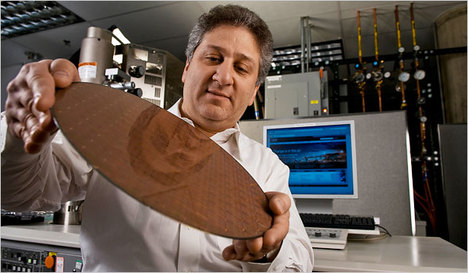 “Daniel Edelstein of I.B.M. Research is leading a team’s work in the use of self-assembling nanotechnology.” Source of caption and photo: online version of the NYT article quoted and cited below.
“Daniel Edelstein of I.B.M. Research is leading a team’s work in the use of self-assembling nanotechnology.” Source of caption and photo: online version of the NYT article quoted and cited below.
(p. 4) Until now, as chips became smaller, they also became faster in about the same proportion. It’s still true for transistors, but it’s no longer true for the wires used to connect transistors — and that slows performance gains. Daniel Edelstein, a program manager and fellow at I.B.M. Research, says, “We’re running out of steam.”
Mr. Edelstein is leading a team of researchers from inside and outside I.B.M. in developing a new way to solve the problem: using “self assembling” nanotechnology to make better insulators, raising performance. In this case, self-assembly involves creating so-called airgaps, vacuums a few nanometers wide that keep the billions of tiny copper wires in a chip from touching one another, instead of putting down a layer of insulating material and trying to align it effectively at the nanoscale. It’s more efficient, and it means that I.B.M. won’t need to spend $50 million on photolithographic equipment.
. . . While the technique is not quite done being tested, John E. Kelly III, I.B.M.’s senior vice president for research, says that “there is no question in our minds this is going to work,” and that I.B.M. will move to it by 2009, first for an existing high-end processor or a next-generation chip, then across its fabs.
Mr. Kelly says Mr. Edelstein has a “unique” ability to solve problems and work across the company to commercialize new technologies. In the last decade, he has led two other important breakthroughs, most notably the use of copper for the wires inside chips, replacing aluminum.
Each time, Mr. Edelstein has done it by working with a small group of two or three scientists to explore out-of-the-mainstream approaches to problems. He also goes beyond research, getting to know the manufacturing team to help him understand what it takes to get a novel technique into I.B.M.’s existing manufacturing process.
For the full story, see:
MICHAEL FITZGERALD. “PROTOTYPE; Trying to Put New Zip Into Moore’s Law.” The New York Times Company, SundayBusiness section (Sun., February 24, 2008): 4.
(Note: ellipsis added.)


I wonder what the penalty is for breaking Moore’s Law?